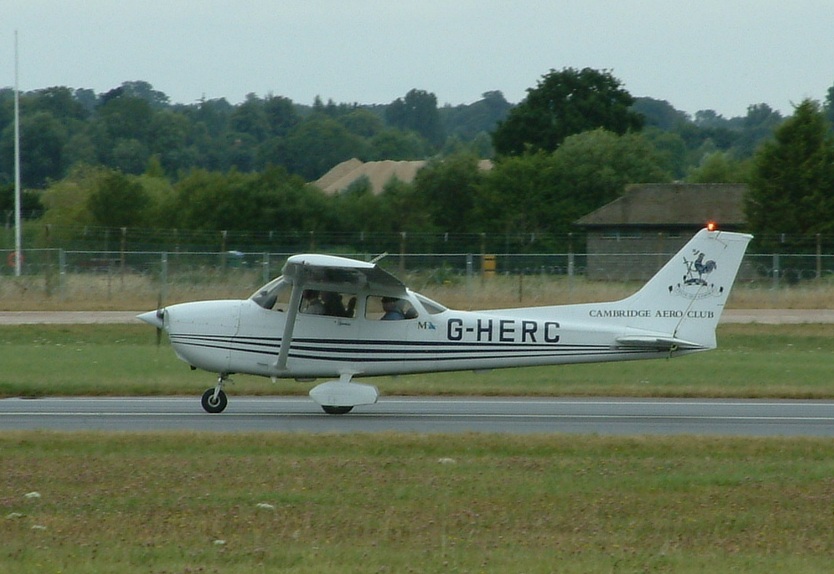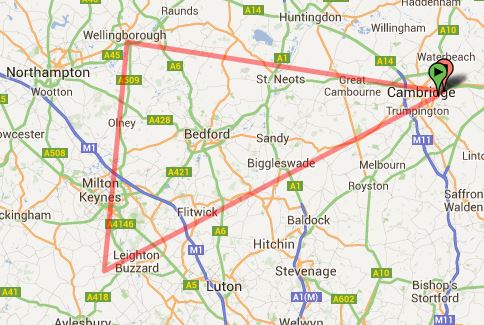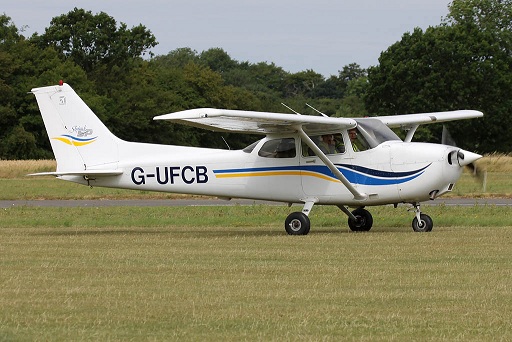For a variety of reasons my training log had a selection of gaps in it, things that had been done but not signed off, or we’d gone up to try and do but couldn’t for one reason or another. So this lesson was aimed at cleaning up the list of things to do.
Flying with yet another new instructor, that makes it about 10 instructors I’ve flown with to date on the course of this learning to fly adventure.
Briefing
Things we wanted to get done today:
- Base Leg Circuit Join
- Traffic Service from an ATSU
- Aerodrome Traffic Zone (ATZ) Transit.
- Diversion Procedure
- Low Level Navigation
- Revision of Unsure of Position / Lost Procedures
There was no fixed route for today, but I was asked if I could get the instructor to RAF Wyton. Figured if it’s on the map and we had enough fuel, there was no real reason I couldn’t get there, so we’d have a go 🙂
Plane Checkout
We’d take G-HERC, for those not wanting to read back through the blog this plane looks, feels and flys like it’s quite shiny and new and someone has taken good care of it. It’s also the plane I flew my first ever solo in so I’ve no real objections with it.
And as expected it was looking like it always looks…….happy to go flying.
No major issues so it was just a case of cracking on and getting taxi clearances and such like.
Up, Up and Away…..Traffic Service Please
Once above 600ft and starting a climbing turn we switched to Cambridge Approach and as they are a full up Air Traffic Control Service, asked them if we could get a “Traffic Service” – in essence we’re saying we’d like them to tell us all about the traffic around us. This doesn’t remove the emphasis on us to be looking out of the window, we’re flying visual rules after all. It does however mean we get a reasonable chance to know about things that we can’t or haven’t yet seen.
Unfortunately it was just past 9:30am and the call back was “Sorry we’ve only just turned the Radar on, can only provide basic service.”
That’d have to do and I guess we won’t be getting our traffic service today 🙁
Out to RAF Wyton
Plan of attack was to climb out from runway 23 and turn right, heading towards RAF Wyton which is North West of the airfield. Once you get your bearings of the world and roads etc. it’s not actually anything like as hard to find as I was thinking it might be.
Of course the reason for flying to RAF Wyton was because they have an Aerodrome Traffic Zone (ATZ) and the idea was to call them up and see if we could get permission to descend and fly through their ATZ. An ATZ is controlled airspace from the surface up to 2,000ft and you cannot fly through it without permission, you can fly over it, but through it requires a request for a “Zone Transmit” and being granted permission.
Having got cleared to switch over to their frequency and calling them up with our call sign, I was met with radio silence 🙁 We tried again, but clearly nobody was home today, damn.
This meant we’d have to knock on someone elses door to tick the “Zone Transmit” box of my training sheet – if only there was an airfield nearby, one that had an ATZ and an air traffic controller known to be about…. Hang on, didn’t we just leave such an airfield? 🙂
Diversion Practice
Time to pretend that a town was actually a big rain cloud and divert around it. Not a whole lot more to this than to point the plane 45 degrees to the right, time a journey of about a minute, then turn 45 degrees left, fly for a bit until past the problem and then turn 45 degrees left and fly the same minute back on to the original track.
To be honest it was good practice but you can’t go far wrong when you can see your destination at all times – towns make rubbish rain cloud simulators 🙂
Low Level Navigation
To mix it up, we descended to around 800ft above ground level, this is just above the legal low flying limits over non-built up areas and as you quickly learn, is pretty low. It’s 200ft below what you’d fly in the circuit if you were coming in to land….and if the engine cuts out you’ll have at best, 2 minutes to decide what you’re going to do next before hitting the ground!
However, we were down at this height in order to practice some properly low navigation, the world is very close at this height and even the smallest hamlet and local back road are visible (and wizzing past at ~115 mph).
The objective was to pretend every block of houses or built up area was in fact an impassable cloud to be navigated around.
A lot of fun!! – A lot to think about, as altitude holding becomes quite key at this height for this duration, but a lot of fun.
Having ducked left of Bourn airfield, we carried on a few more miles and then it was time to climb and go and find our ATZ.
Zone Transit and getting “Lost”
They might not have turned their radar on yet, but Cambridge were at least happy to entertain us for letting us fly straight through their ATZ at 1,500ft (under strict orders to not deviate altitude).
With the blessing of air traffic control, a zone transit is just a matter of flying a straight line and reporting position if/as required. Cambridge is a busy airport and you get every sort of traffic you can possibly imagine (Spitfires and Red Arrows, to C-130 and 757’s), but being busy and having this sort of traffic also means it’s very procedural – unlike smaller airfields supported by a ground to air radio service for example.
Having reported overhead of the aerodrome and continued on our way out to the east, it was time to get a bit of practice in on the Uncertain of Position & Lost Procedures.
Just because you’re unsure of where you are, doesn’t make you lost.
We knew were we were recently (flying over a fairly big airport), that wasn’t so long ago, so:
- Keep flying in the same direction
- Note the time now
- When we last knew positively where we were.
- Check the heading against the log – have we wondered off course or are we still flying the intended heading?
- Is the Heading Indicator aligned with the compass?
- Have a look outside, anything to give us a clue (a railway line, a wind farm etc.)
- Is the radio serviceable?
- Are we good for fuel?
We should now have set-up some options and know some limits (we shouldn’t be dangerously low on fuel and not in the ball park of an intended airfield, but you need to know because it’s going to dictate how much time you have to sort things out). If we know when we absolutely had confidence in our position and we know the time and heading we’ve flown since, we can begin to piece together a circle of uncertainty. At ~100 miles an hour you can cross the country at its widest point in around 3 hours, so you don’t want to go to long without having confirmed your position, but equally it’s worth noting that with a couple of hours of fuel, you can cover quite a distance to recover the situation.
Of course if the radio is working then through the wonders of VHF Direction Finding (VDF), as long as we know ball park where we are, there’s a fighting chance of getting a QDM (Magnetic Track to a station) and be good to go within a few minutes.
Should all of our options and best attempts come to nothing, we always have the emergency frequency of 121.5Mhz. It’s not going to be great to have to announce a PAN on this frequency, but if you’re truly lost, it’s better to confess then to press on and run out of fuel or something equally silly for the sake of trying to save some pride. At the end of the day people are going to think you’re more of an idiot if the AAIB report that you had plenty of fuel, a working radio, but pressed on without seeking help until you didn’t have either….
Walking my instructor through the procedure, establishing when we knew where we were and how long we’ve been flying to be honest it was good practice but when you know where you are because of local knowledge it’s very easy to piece it all together and sound like you know what you’re doing.
Time to head back then and get another tick box ticked off if ATC would play fair.
Base Leg Join
A standard overhead join has you coming in crossing the aerodrome at 2,000ft, descending turning over the deadside of the airfield to circuit height and then slotting in around crosswind end of the runway. It’s not actually the simplest thing to do, but more importantly, it’s quite slow and if you’re approaching the airfield from the non-standard overhead join direction things get even more complicated as you have to fly overhead, then turn back, then descend deadside…..
Standard Overhead Join – CAA
As you can see in the diagram, if you join on the base leg, it cuts a whole heap of that out – as the base leg is the last leg before turning for final approach.
If you can get ATC permission to do it, then it has the potential to save you time and money. However, it comes at the price of removing all that time you’d normally have in the circuit for getting your act together and running through the checklists. Now you need to be thinking about things much sooner.
Air Traffic entertained our request, but with one catch:
Golf Romeo Charlie – Can you Accept 23 Grass?
I’ve landed on the grass enough times to not worry about it, but as this was my first time up with this instructor there was a quick glance and a “I’ve done it before” and then I was good to reply back and confirm the grass would be fine.
It was coming down quite nice, I was just thinking it was going to be flat when with the most gentle of taps (if even that), we were down. A little fast, but unbelievably flush – in fact I couldn’t have put the wheels down more gently on the main runway! Easily my most gentle of touch downs to date.
Next lesson: Navigation Aids. That Nav. Exam is starting to be a pretty urgent issue, I should start revising! 🙂


